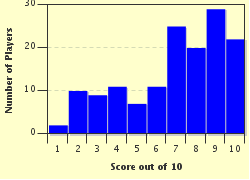Quiz Answer Key and Fun Facts
1. The Picts were a conglomeration of peoples located in the dark blue area of this map. To the south, many different groups ruled including the Britons, the Anglo-Saxons, and even the Roman Empire, but none of them were ever able to fully conquer the Pictish lands. What was the Roman name for these northern lands?
2. The first historical records of the Picts were kept by the Romans, who considered them barbaric and uncivilized. In this illustration, you can see such a dramatization. The Romans named them the "Picti", which means what?
3. Since most of the historical accounts of the Picts comes from their enemies, it is important for historians to try and glean as much unbiased information from their artifacts as they can. The artifacts shown here are just a couple of many of what kind of artwork?
4. Pictured is a Pictish work known as the Bullion Stone. In it, a rider with a shield is drinking from a drinking horn that ends in a bird's head. What is unusual about this artwork compared to other Pictish works?
5. The Roman Empire attempted to protect itself from northern raids by building Hadrian's Wall in AD 122. However, they did not simply sit behind this wall and forget about the rest of the lands in the north. In AD 142, Roman Emperor Antoninus Pius started construction of what lesser-known wall represented in red on this map, which was abandoned only eight years later due to Pictish raids?
6. This Pictish work is believed to show the Battle of Dun Nechtain in AD 685. King Bridei III of Pictland was an expansionary king, and he was able to remove the troops of what foreign power from Pictland?
7. King Bridei III of the Picts was determined to push out foreign influence in his lands. He was widely successful in his war campaigns in the south as well as the east. In 682, he led a force against what area colored in red that was so violent that he was said to have simply "destroyed" the region?
8. Pictured is a replication of a certain structure that was common in the estuaries of Scotland and Ireland. The structure is an artificial island built from a combination of stone, timber, or straw. Their construction was at its peak from 800 BC to AD 200, but they were used and rebuilt during the time of the Picts as well. What are these structures called?
9. In the image you can find the Irish missionary Saint Columba, who is known as the Apostle of the Picts. He was well-regarded by the Picts and helped them convert to Christianity in the sixth century. Before the arrival of Columba, the Picts practiced a form of Celtic polytheism, which is sometimes referred to by what other name?
10. Some historians in the past believed that the Picts mysteriously vanished, and this lent them an aura of mysticism. However, most historians now believe that the Picts were simply assimilated into what cultural group represented in red here?
Source: Author
trident
This quiz was reviewed by FunTrivia editor
bloomsby before going online.
Any errors found in FunTrivia content are routinely corrected through our feedback system.

